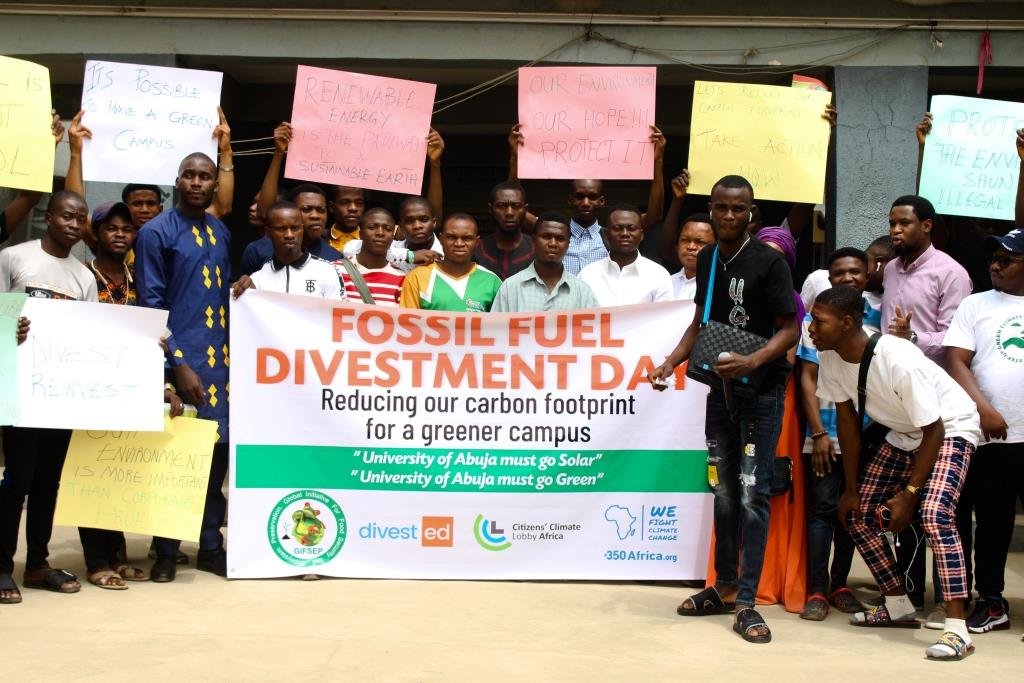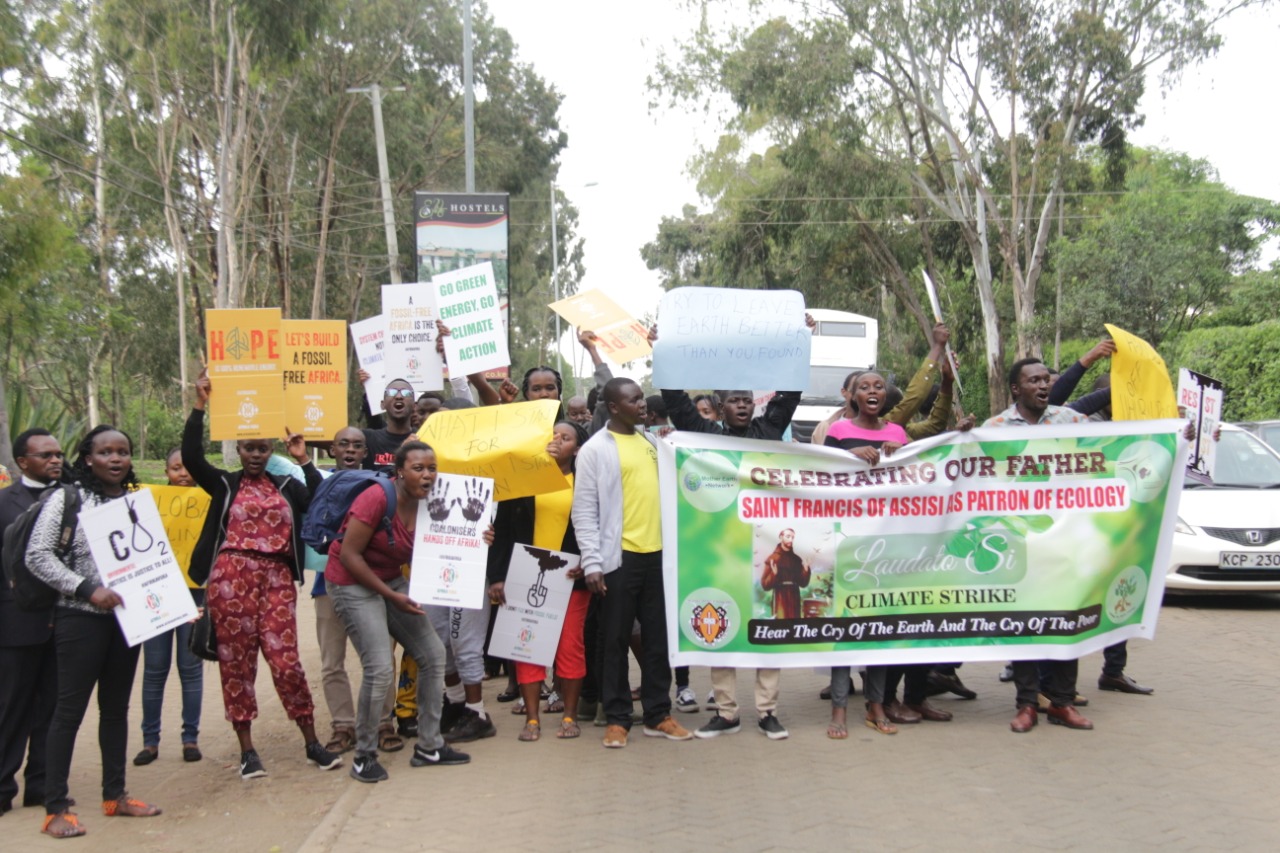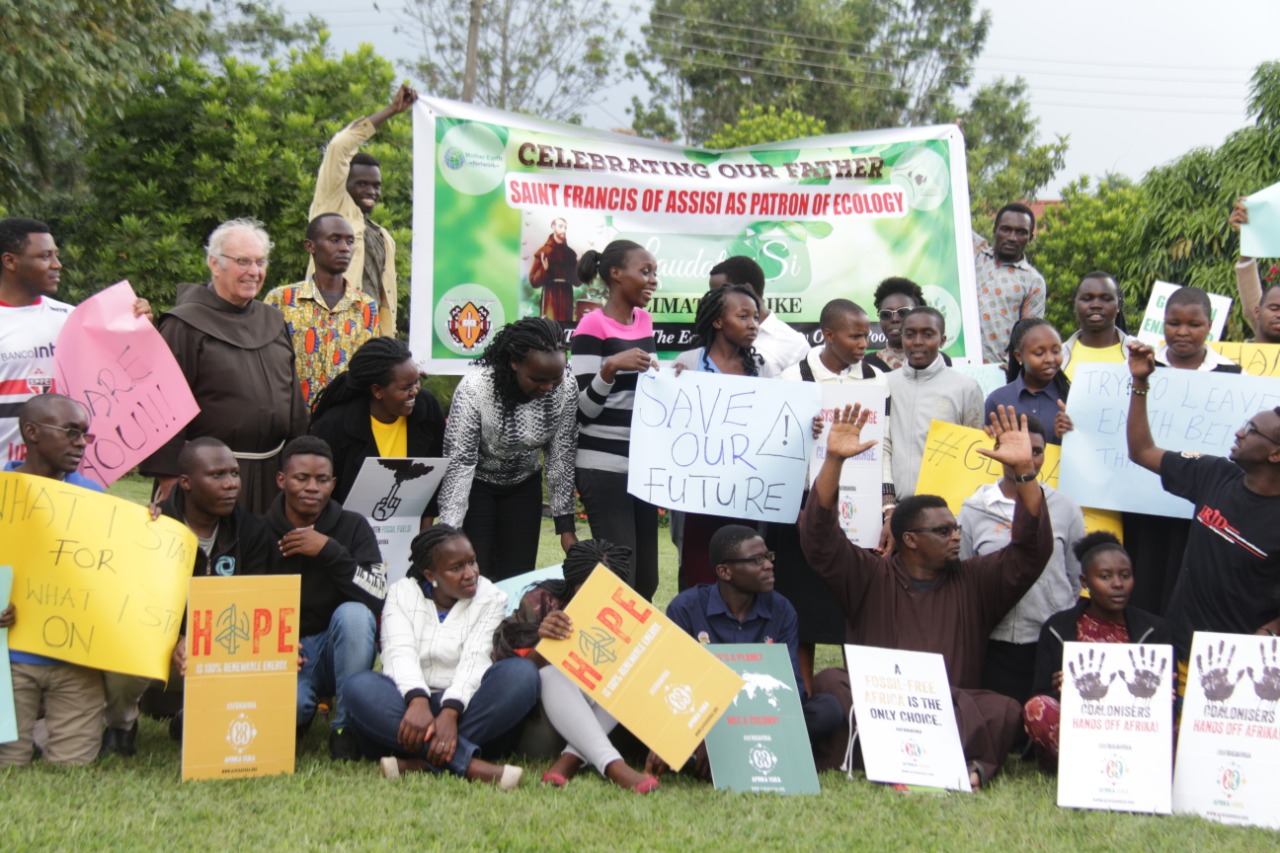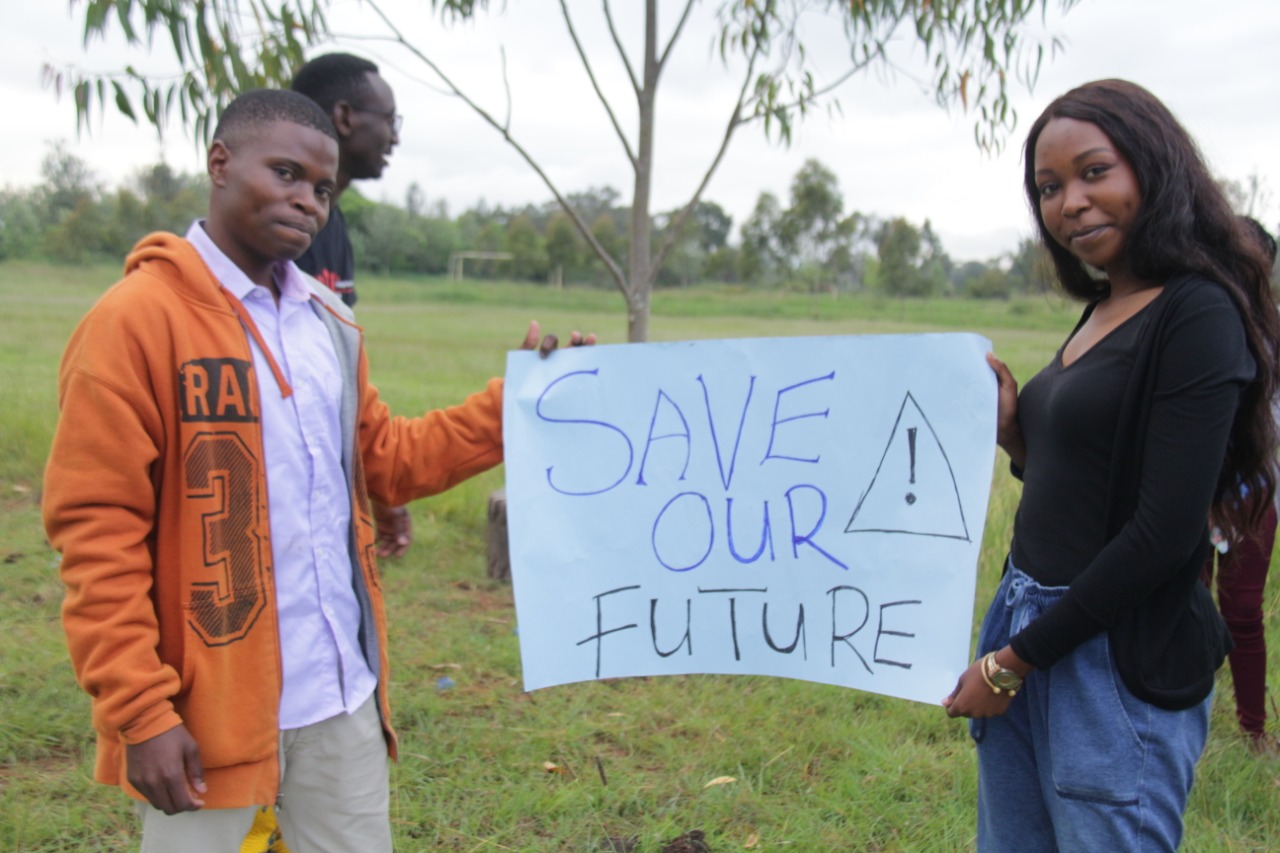Kenya and Nigeria joined divestEd!
Divestment from fossil fuels has been gaining quite the momentum globally in the last few years. This week two youth groups in Kenya and Nigeria took action, joining the Fossil Fuel Divestment Day.
On 12th February, students in the Chiromo campus of the University of Nairobi, Kenya engaged in a 1-hour sit-in session. The forum attracted over 40 participants and took the form of a participatory dialogue to exchange on the need to invest in renewable energy in the campus, its advantages, as well as reaching out to other campuses to follow suit. The students, mostly drawn from the Chiromo Environmental Awareness Club and environmental scientists in the making had strong contributions on how renewable energy on campuses could look like, citing the need for academia and researchers to take a lead in implementing solutions to the fight against the climate crisis.
It happened! We are likely the first across the world to host the #divestED event owing to our special circumstances that could not allow us a quorum tomorrow.
Thanks for all students in @ceackenya who hosted us, and keenly contributed to the dialogue. @divesteddotorg pic.twitter.com/jn4zNNShp6
— Y-CEARE (@YCeare) February 12, 2020
Among the emerging issues was the need to have a strong legal requirement that enables campuses and institutions to have renewable energy systems as a part of them going green in energy production and usage. The action was led by Y-CEARE (Youth Coalition for Environmental Advocacy and Renewable Energy), a team part of AfrikaVuka.
In Nigeria, GIFSEP (Global Initiative on Food Security and Ecosystem Preservation) held a workshop on reducing carbon footprint, followed by a mock protest within the university of Abuja, targeting students from the department of geography and environmental management. The team intended to encourage the department to join the ongoing efforts to transition from fossil fuels addiction to renewable energy. Students specifically asked the university administration to switch to renewable energy and install solar panels on top of administrative and campuses blocs.

When asked about what to expect after this divestEd initiative, Joseph Ibrahim of GIFSEP said “We are still having issues of unstable electricity supply. We believe this initiative will inspire the students and the university to take on renewable energy and create an example for other campuses and schools and hopefully Nigeria as a whole. ”
I was at University of Abuja today to make a climate change presentation and joined the students to demand for a greener campus #F2D2 #FossilFuelDivestmentDay #Afrikavuka pic.twitter.com/0J1CMcunDl
— Joseph Ibrahim (@joeibro) February 13, 2020
Both teams joined the Fossil Fuel Divestment Day or divestEd, a mobilisation moment led by US divestment students to demand specific institutions to divest from fossil-fueled destruction of land, air, and water and re-invest in renewable energy.
Author: Rukiya Khamis, 350Africa.org Anglophone Field Organizer.
Celebrating the 40th anniversary of St Francis of Assisi as patron of ecology by striking for climate
November 29th this year coincided with the 40 year anniversary of Saint Francis of Assisi as Patron of Ecology. He was declared by Pope John Paul II in 1979 on the same date.
Mother Earth Network in collaboration with The office of Justice Peace and Integrity of Creation Franciscans Africa celebrated the anniversary by striking for climate in the afternoon of Friday, November 29th November, from 3.00 pm to 6.00 pm.
The event brought together 120 participants: Franciscans brothers and sisters, Secular Franciscans, Youfra, the climate movement group from The Catholic University of Eastern Africa and other stakeholders.
The event started with a learning session of conscientization about Laudato Si and St Francis of Assisi spirituality. The discussion was also focused on COP25 happening in Madrid, Spain. In the same regards, some interviews and testimonies were recorded to be shared worldwide.
After that, we e then started the walk for climate justice from the Franciscan Family centre towards The Catholic University of Eastern Africa. During the walk, people were carrying placards and banners with messages like. No need for fossil fuel in Kenya, Mr President to stop any oil business in Kenya, For people in COP25 to honour Paris Agreement etc. The event ended by planting 200 trees for the commemoration of St Francis of Assisi 40 years as patron of ecology.
By Steeven Kezamutima, JPIC Franciscans Africa
UNESCO has a chance to protect Sundarbans. Will it?

Have you heard of the Sundarbans? On the southern coast of Bangladesh, this precious forested area is home to 4.5 million people and the royal Bengal tiger. It’s a place of immense cultural heritage, sustaining local fisher communities and livelihoods.
But something is wrong. Industrial development – coal in particular – is threatening the air, water, and climate for the people of the Sundarbans. Locals in the area, supported by the global Bangladeshi diaspora, have known about this and campaigned for protection for years. But new aerial footage showing the extent of the damage makes it undeniable – action is needed right now to protect the Sundarbans for good. Click this video to watch:
New satellite images show the proximity of Rampal coal plant area to Sundarbans Reserve Forest and Dolphin Sanctuaries. @UNESCO World Heritage Committee must stand up to coal and list Sundarbans as a heritage site in danger. https://t.co/ESPz8spnUV #SaveSundarbans pic.twitter.com/MLwc9rYHz6
— 350 South Asia (@350SouthAsia) July 1, 2019
In June, the International Union for Conservation of Nature, the official advisor on natural World Heritage recommended that UNESCO should list Sundarbans as a World Heritage Site in Danger. IUCN recommended placing the Sundarbans, the world’s largest mangrove forest on the endangered list due to numerous threats from coal plants and increased industrial activist in the region.
These recommendations came as the construction of the Rampal coal plant continued despite the World Heritage Committee in 2016 asking the Bangladesh government to cancel the Rampal coal plant. Additionally, two more coal plants are currently being developed on the Payra river, which flows on the same bay as the Sundarbans. Over 150 industrial projects are being developed upstream.
The recommendations of IUCN are being fiercely opposed by the Bangladeshi government– despite our current climate crisis and record heatwaves in the region last month.
UNESCO delegates are currently meeting in Baku, Azerbaijan - and they’re due for a decision on whether to add the Sundarbans to the list of Endangered Sites.
Now is our time to pile on the pressure. Bangladeshi activist Tonny Nowshin and Kenyan organiser Rukiyah are Baku right now to make sure UNESCO hears our message. You can follow them on Twitter and stay updated on the day’s happening at the UNESCO meeting in Baku, Azerbaijan.
As @UNESCO delegates meet in Baku, Azerbaijan this week @350 campaigners @Rukiya_Khamis & @t_nowshin are there to convince them to add the Sundarbans and Lamu in Kenya to their list of Endangered Sites https://t.co/btaOZtVyL4 Follow them for all the latest pic.twitter.com/GNrKAqOew0
— 350 dot org (@350) July 1, 2019
Show your support for the people of Bangladesh, Kenya and communities around the world facing down new coal developments! To tell UNESCO: Stop the coal plant, save the Sundarbans
Sign the petition to Save the Sundarbans
The Lamu Coal Plant project in Kenya has been stopped by a court decision
Our friends and allies in Kenya just won a tremendous victory -- the National Environment Tribunal (NET) of Kenya has cancelled the licence previously granted to Amu Power, the developer of the controversial Lamu Coal Plant.
After years of inspiring and creative campaigning from the climate movement, the Kenyan National Environment Tribunal (NET) has just cancelled that license, citing the lack of effective public participation and social and environmental risks among other reasons.
Petitioners from Lamu celebrating the NET judgment. National Environment Tribunal observed that public participation and EIA study are the oxygen in any project. And that they can't excuse non-compliance. #LamuCoalJudgment #deCOALonize pic.twitter.com/dn6xdfJfdz
— deCOALonize Kenya (@deCOALonize) June 26, 2019
This is a huge victory for the climate movement, environmental rights, for the Lamu community and for our planet. Join us in the celebration: watch and share this 1-min video on Facebook, Instagram, or Twitter and help the news spread far and wide!
This outcome proves once again that people power is unstoppable -- and that when we mobilise and fight, we win. From emails, social media shares to the creative protests and letter-writing campaigns we helped organize, from small and localised meetings to huge rallies, we pushed and pushed and didn’t give up, even in the face of intractable targets.
This momentous ruling is a major step toward a fossil free Kenya.
What the deCOALonize movement accomplished in Kenya is the kind of bold and visionary action that puts us on the offensive against the fossil fuel industry. We need more of this kind of action in Kenya and around the continent. .
Today, we take a moment to celebrate. And tomorrow, we get back to work. We’ll keep the pressure on our elected officials at all levels, and fight for our climate and safety of our communities. City by city, province by province, country by country we won’t stop working to build people power for bold action that matches the scale needed to avoid catastrophic climate impacts. Share the video on your social media to help spread the word about this milestone!
This unprecedented victory is proof that by collectively fighting for a more just and sustainable world, we’re able to defeat the devastating fossil fuel industry — and widen the horizon of the future we can create.
This victory is also a signal to every other governments, countries and multinational: Africa is not for sale. Together, we can start building a Fossil Free Africa.
PR: deCOALonize Campaign partners and Greenpeace Africa Demand a Stop to Coal Investments in Kenya.
Nairobi, 12 June 2019 – Communities from Lamu and Kitui together with Greenpeace Africa and members of the deCOALonize coalition have today handed over letters to the Ministry of Energy and the Chinese Embassy. The letters are calling on the Cabinet secretary, Hon. Charles Keter and Chinese corporations to stop investing in Lamu and Kitui coal projects and instead invest in renewable energy.

The anti-coal activists marched from Uhuru Park to Nyayo house where the Ministry of Energy is housed and then proceeded to the Chinese embassy to express their discontent over the planned Coal Power Plant in Lamu and coal mining in Kitui.
Coal burning is the number one source of air pollution worldwide. The true cost of coal is destruction at every step- damaging people’s health through air pollution, using up and polluting scarce water resources and contributing to the climate crisis. This coal project will also destroy mangrove forests and local livelihoods, in an ecologically rich area of Kenya - Lamu - which is recognised as a UNESCO World Heritage site.
“Our cultural heritage and livelihoods are threatened. The Lamu coal plant will ruin tourism and Lamu Old Town - destabilizing the county’s economy and the environment. Our people will face the most health risks from this plant. The government must prioritise the protection of local communities and the environment,” said Mohamed Mbwana From Save Lamu.
“There is no need to build centralized dirty sources of energy such as coal to answer to Kenya’s energy demands especially when the country is taking the lead in Africa with 85% renewable energy base. With access to wind, solar, geothermal and tidal energy sources, Kenya’s renewable energy potential is cost-efficient and causes no harm to the people and environment,” said deCOALonize Campaign Coordinator, Omar Elmawi.

Climate crisis remains one of the biggest challenges facing humankind. Throughout the world, countries including China - directly linked to the project - are divesting from coal. Studies have shown that the social, environmental and economic costs of running coal-fired power plants exceed the benefits.
“Climate crisis has crippling effects on developing economies; fossils fuels such as coal exacerbates these effects. Kenya cannot afford to ignore this anymore. It's time to quit plans for dirty, highly polluting coal and invest in renewable energy,” said Greenpeace Africa’s Senior Political Advisor, Frederick Njehu.
Kenya currently produces more energy than it uses. However, electricity access to urban, peri-urban and rural communities is still limited due to a centralized energy system. Investing in a robust decentralized grid system will allow for better access to electricity to industries and households. Investments in the energy sector should go towards expanding the grid network.
Kenya’s president has committed to 100% renewable energy by 2020. Greenpeace Africa and deCOALonize in solidarity with the local communities in Lamu and Kitui would like to hold President Uhuru Kenyatta accountable to this commitment and call on him to halt all investments towards coal in Kenya.
Notes to the Editor:
● Open letter to the Chinese government
● Letter to Ministry of Energy
Media Contact:
- Hellen Dena, Greenpeace Africa’s
- Communication Officer, hdena@greenpeace.org, +254 717 104144
- Omar Elmawi, deCOALonize Campaign, omar.elmawi@decoalonize.org, +254710343432
Kenya doesn't need coal, Report reaffirms
A new report on the proposed Lamu coal plant in Kenya reveals that the project is a huge mistake in terms of investments, excessive power generation and electricity costs for consumers.
The report entitled The Proposed Lamu Coal Plant: The Wrong Choice for Kenya presented on the10th of June in Nairobi cautioned that the project would be ‘locking the country into a 25-year deal at a cost to consumers of more than US$9 billion, even if the plant never generates any power”.

Some of the highlights of the report which was compiled by the Institute for Energy Economics and Financial Analysis (IEEFA) include:
- Amu Power’s claims for the cost of Lamu-generated electricity are unrealistically low, based on outdated costs for the imported coal that will be burned and on overly optimistic assumptions about how much electricity the plant will generate.
- Using more realistic assumptions about future Lamu generation and coal costs, electricity from the plant could cost as much as 75 cents per kilowatt-hour (KWh), on average, during the years 2024 to 2037—more than 10 times what the plant’s proponents have claimed.
- This estimate does not include costs for port upgrades that would be required to bring coal to the plant, nor construction of the transmission infrastructure needed to distribute the power; the costs of these projects would add significantly to Lamu’s overall impact on electricity consumers and taxpayers.
The report also reaffirmed that the country doesn’t need any coal generation project, but should rather actively explore its abundant renewable resources to satisfy the likely growth scenarios.

Reacting to that release, the Kenyan government said it intends “to delay the Lamu coal-fired power plant to avoid a situation where Kenyans will end up paying for unused power if demand fails to keep up with the project’s output”.
“The coal plant will be built in the next four to five years as part of the Government strategy to delay new power over cost concerns’ said the Energy Principal Secretary Joseph Njoroge
This is a great move in this campaign which has been going on for over five years. Lamu residents, activists, scientists and other social justice groups had fiercely challenged the project, pointing out its numerous dangerous impacts in terms of people’s health, livelihoods and ecosystems.
Author: Rukiya Khamis.
AMOS WEMANYA: Coal-fired power a needless burden
Kenya’s energy sector has made promising developments. This year is set to be an exciting one for electricity consumers. There has been a notable shift in the direction the government wants to take for investments in the country's energy future. This move is contrary to the initial plans to invest in the dirty coal power plant in Lamu and mining in Kitui. President Uhuru Kenyatta has promised to lead Kenya to 100 per cent clean energy by 2020.




